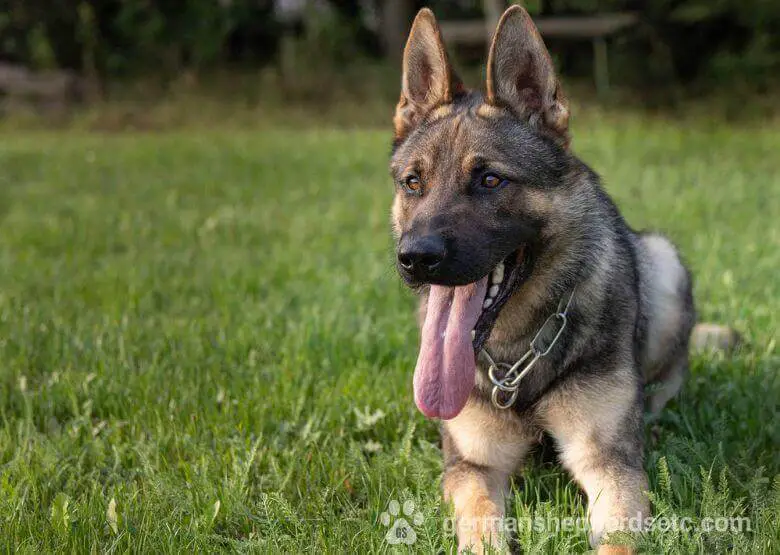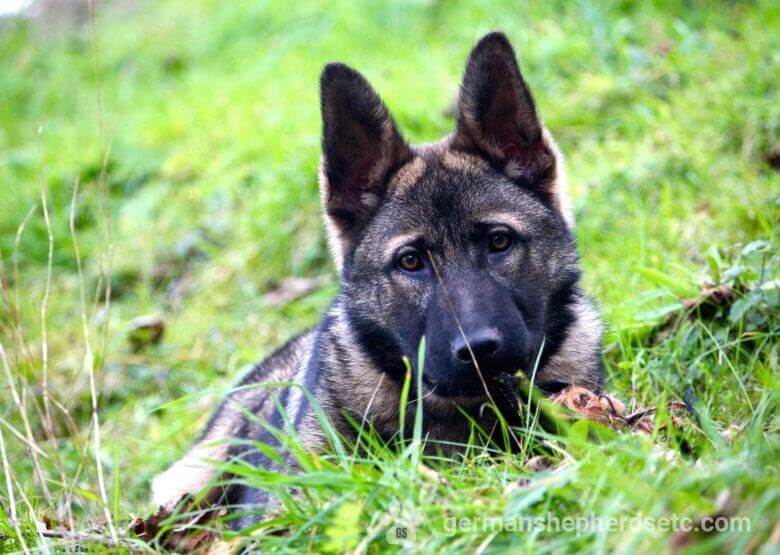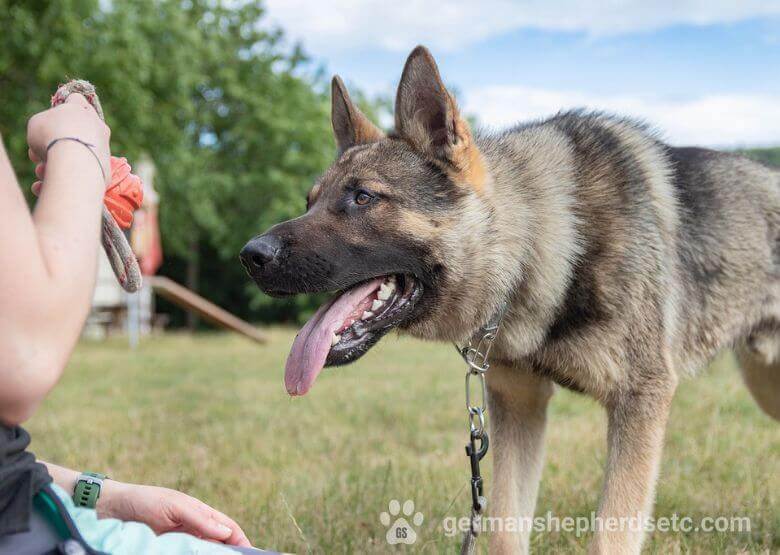Table of Contents
German Shepherd dogs are a very popular dog breed in the world, and they stand second in popularity in the American Kennel Club. Everyone knows that there are two types of German Shepherds – a show line and a working line. They differ in their body look and working drive. However, even among working-line GS, there is one variety that stands out. It is a Czech German Shepherd, the animal with strong working ethics, a straighter back than that in show Shepherds, denser and longer bones, and a more extended life span that makes it less prone to most poor health conditions characteristic of all other German Shepherds.
This Czech working-line German Shepherd is relatively a new dog variety that appeared in former communist Czechoslovakia as a perfect dog for the military, law enforcement, and guarding.
The average Czech German Shepherd price is about $2,000, with a range of $1,000-$4,000, depending on the demand in a specific area, bloodline, breeder, the litter size, health condition, and the availability of medical certification, registration, microchipping, vaccinations, and veterinary fees. The only thing is – to buy such a puppy from a reputable breeder to be sure that you acquire a purebred dog.
We have compiled the most prominent features, and information about the character, behavior, and way of taking care of this animal, training, and exercising it. So, if you are interested in getting a Czech Shepherd for your household needs, you have arrived at the right place.
History and Origin of Czech German Shepherds
Though all German Shepherds are traced back to Horand von Graffrath, the founding dog of this breed, three are different varieties that originated in different countries from the first German Shepherd dogs’ offspring. They were bred for different show line and working line purposes, and so they are different in body structure, color, temperament, and skills. A Czech GSD is one of such remarkable varieties.
A Czech German Shepherd was bred as a working dog in communist Czechoslovakia in 1955. There was a special Czech Alsatian breeding program meant to adapt the already existing GSDs to law enforcement services. That is why attention was paid to the qualities allowing them to guard the borders and control strangers. So, there has been the misconception until nowadays, that these dogs were bred for aggression.
Czech or Czech Alsatian German Shepherds originated from the DDR German Shepherds and then, partially replaced these dogs in the military, border guarding, and police services. However, the Czech Shepherds were not as popular as East and West German dogs until 1989 when they began to be bred as family dogs.
Czech and Eastern German Shepherds are often compared to each other. Though they originate from the same breed, these varieties are different.
Czech GSs are bigger and bulkier. They can display more colors, such as all varieties of sable and solid black, while DDR Shepherds are darker and smaller in size. The Czech German Shepherd life span is also extended – they can live up to 15 years or even longer under the proper care. They are also less prone to diseases characteristic of German Shepherds, such as hip and elbow dysplasia, which accounts for a longer life span, too.
The aggression and friendliness of these dogs can develop equally, depending on the purpose of breeding, so we cannot say that these dogs are more aggressive than others. So, nowadays, they are widely adopted as good family dogs.
Appearance and Characteristic Features
The Czech Shepherd variety is characterized by almost the same traits as all German Shepherds. The most apparent features are strong jaws, pointed ears, and heavy skulls. However, there are significant differences in weight and height because a Czech German Shepherd is heavier and bulkier due to its strong muscles and denser skeleton. The Czech German Shepherd weight is 66-88 pounds (30-40 kg) for males and 49-71 pounds (22-32 kg) for females. The height is 24-26 inches (61-66 cm) in boys and 22-24 inches (56-61 cm) in girls. That makes them look much bigger and more aggressive than other working lines. However, if you are looking for a really huge German Shepherd, King GS is your better choice.
Since this variation was bred specifically for military and police purposes, they have thicker paws, broader chests, stronger stamina, and a more intimidating look.
Czech Shepherds can be mostly of sable color with the Agouti pattern. It looks more like a wild wolf. Many of them can be of solid black color or a combination of sable and black. This color, together with hard-to-spot eyes and a powerful physique, is meant to make an impression on potential intruders and scare them away.

Behavior and Temperament
Being a variation of the German Shepherd breed, Czech GSDs possess the same characteristics of temperament and personality. They are intelligent, loyal, and well-trained. However, there is some difference we want to discuss here for you to decide whether such a dog can be a good choice for your family.
Czech Shepherds were initially bred as the dog variation to guard the border, serve in the military, apprehend criminals, and stop people from escaping. That is why they are often considered to be prone to aggression and strong-headedness. However, if properly trained, this animal can become your most admirable family member, a reliable protector, and a good addition to any family with young kids.
The most prominent characteristic feature of the Czech German Shepherd working line is their loyalty to the owner. It is so immense that sometimes, if not properly trained and managed, it can turn into an obsession. When you socialize your puppy from an early age and teach it how to deal with other people and animals from the age of 8 months or so, you won’t have problems with a one-owner devotion, and your dog will be friendly and loyal to all your family members and kids. The protective instincts of these dogs are so strong that, if left uncared, they may lead to issues with everybody who wants to enter your house or backyard.
Czechs are also considered to have a ‘hardcore’ personality. However, they can be just as sweet, goofy, and cute as any other varieties of German Shepherds. The only difference is that they are always ready to come back to their working mode immediately.
Due to their intimidating look, Czech Shepherds can be strong and reliable home protectors. However, their strength and energy demand a large house or a backyard they can use for running and exercising. If you live in a small apartment or don’t have a backyard, this breed is not the most appropriate choice for you.
Among other traits of Czech GSDs, we can distinguish that they do not bark so much as other German Shepherds, and it can be a benefit for those owners who don’t like excess barking. You also need to teach them not to jump at people, especially children, at a very early age to avoid problems related to their huge size and a lot of strength in the future.
As a working line, these dogs are great at all the jobs related to tracking, sniffing, and protection. They should know how to distinguish between real and imaginary threats because an untrained dog can attack everything and everyone it considers to be dangerous. They are also very intelligent, so training them to follow commands is a pleasure. Their working ethics are admirable.
Due to these dogs’ powerful stamina and machine-like effectiveness, they are great for such jobs as:
- personal guards and companions;
- carrying tactical gear;
- searching and rescuing;
- sniffing and sorting;
- hunting (to be trained from a very early age).
All these skills are especially useful in the military, rescue parties, police, personal and business protection, and working at airports, state borders, and other large gates. They can even do better at these jobs than Eastern German Shepherds.
If properly trained, they can become perfect family guards. The only thing to remember is that, if you take a Czech German Shepherd from a shelter at an adult age, you need to be very careful about its skills and displays of aggression. It may be lacking love and affection, and its instincts may prompt it to attack everyone who approaches you.
Czech German Shepherd Feeding
It is a large dog breed, very strong and energetic, so it needs a lot of high-quality food for proper nutrition. You should feed your puppy 3 times per day with 2-3 cups of kibble, and your adult Czech will need 3.5-5 cups per day with 2 times of feeding. Feeding your dog natural food is also a good choice, but you will need to talk to your veterinary about it.
You need to keep a big bowl of fresh water at your dog’s access all the time. Because of its more energy spending and working ways, you need to give your pet nutritious supplements for endured physical activity. You should always check the weight of your doggy. Underweight or overweight conditions can equally lead to health issues.

Health Conditions and Care
You do not need to worry about any exclusive health issues related to this variation. A Czech German Shepherd is just a variety of the Shepherd breed, so it is prone to the same health conditions as a standard German Shepherd. However, these conditions may not be as severe as in other variations of the breed.
The possible issues may include eye and vision problems, hip dysplasia, bloating, ear infections, and allergies. Hereditary issues possibility depends a lot on the breeder’s ethics and the first days of the puppy’s life. Some of them may not display until very old age if considered properly.
You may feel comfortable about all the health issues in your pet because Czech GSDs are less vulnerable to different types of health disorders than any other Shepherd varieties. It is due to their proper breeding and appropriate standardization applied from the very beginning.
The average life span of these dogs is also a bit higher than that of other Shepherds. Your dog can live up to 15 years or even more if properly cared for. Its life will be healthier because it is also less prone to age-related diseases, such as different joint and bone conditions.
Your Czech will be a heavy shedder, though. So, its dense coat needs a lot of care, frequent brushing, and grooming even within the seasons which are not related to heavy shedding. At the time, when their coat is prepared for summer or winter, you need to brush your dog even more frequently if you do not want to see your house and backyard completely covered with fur. Moreover, brushing the double coat of your dog frequently will help it avoid overheating if you live in very warm climates. This German Shepherd comes from a snowy region, so it needs its coat management because it has to protect it equally from both high and low temperatures.
You can also bathe your dog if needed but not more frequently than 2 or 3 times per year. Frequent bathing can be harmful because your pet may lose its natural oils protecting the skin.
Czech German Shepherd Training
Training your dog may be easy and pleasant because it is an immensely clever and trainable dog, ready to pick up on different things without much effort.
These dogs were bred as a working line, so their stamina is extremely high. They can walk fast for up to an hour or more without any rest. It means that such an animal needs a very active owner who can accompany it in these walking exercises. If you are a couch potato, this variety may not be a good choice for you.
A Czech dog has more energy and a bigger mass, so it always needs more space to exercise. You should exercise with it one-two hours per day to keep it in good physical condition. The best exercises for your Czech GSD include fetch, off-lead running, and doing tricks. Encourage your doggy with praise and tasty treats if it learns new tricks and the things to fulfill.
Your puppy will also need a lot of training from a very early age. Avoid using force on it. It is very intelligent, so you do not need much time for training and socialization. You can teach it a broader range of skills than the other German Shepherd varieties because it is a working line and is ready to obey and please its owner.

FAQ
Are Czech German Shepherds good guard dogs?
Yes, these dogs are fascinating guards. They can protect your house, family, and property efficiently due to their hardcore and intimidating look, strong protective instincts, and a great desire to please their owners.
How big do Czech German Shepherds get?
This variation of German Shepherds grows bigger and looks bulkier than its other counterparts. Males grow as tall as 24-26 inches (61-66 cm) at shoulders, while females’ height is 22-24 inches (56-61 cm). The weight of a boy is about 66-88 pounds (30-40 kg), and the weight of a girl is 49-71 pounds (22-32 kg) due to their well-developed muscular system.
How much does a Czech German Shepherd cost?
The average cost of this dog varies between $1,000 and $4,000. It depends on the breeders’ qualifications, the availability of medical documentation about a puppy and its parents, the raising, feeding, and training conditions, and other factors that include preliminary vet care and vaccination.
Final Thoughts
When you are looking for adopting a Czech German Shepherd, you need to understand that it is a relatively new breed variation, so you should collect enough information about it before making a decision. This article is meant to let you know as much as possible about these remarkable dogs.
If you have all the conditions and the appropriate environment to get a Czech GSD, you will be rewarded with its extreme intelligence, loyalty, and exceptional trainability. You will obtain a reliable guard, companion, and devoted friend. The only thing is that your leadership qualities should correspond to the personality of your pet. It will always appreciate a great leader in you. However, if you are a first-time dog owner, this choice is not the best one, or you will need a lot of expert help to avoid any issues.
